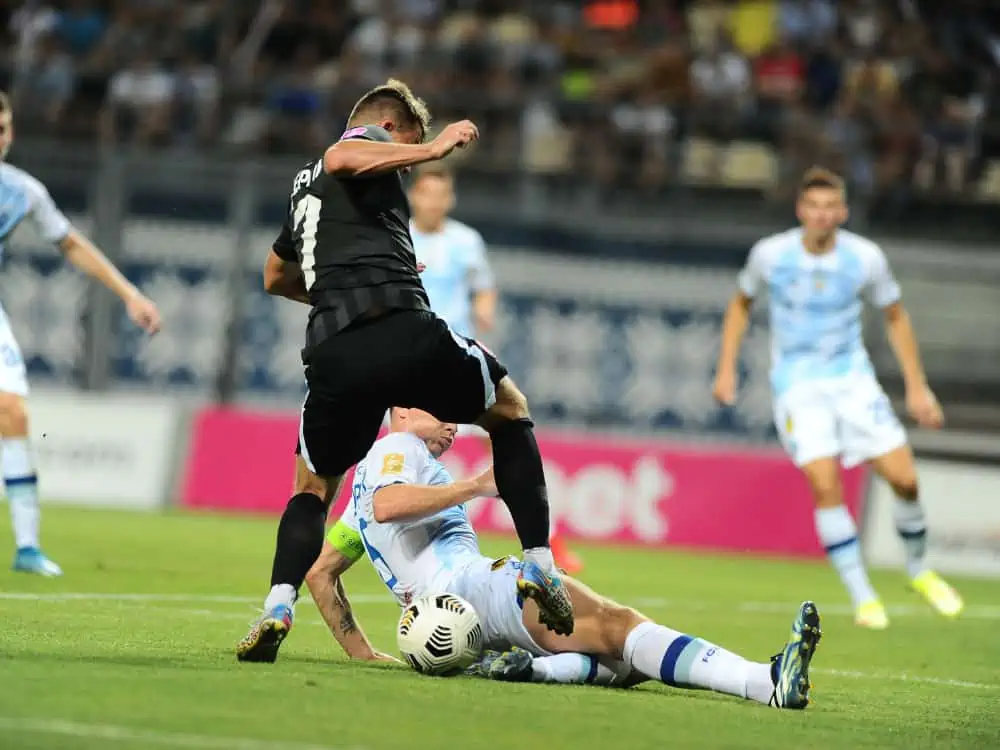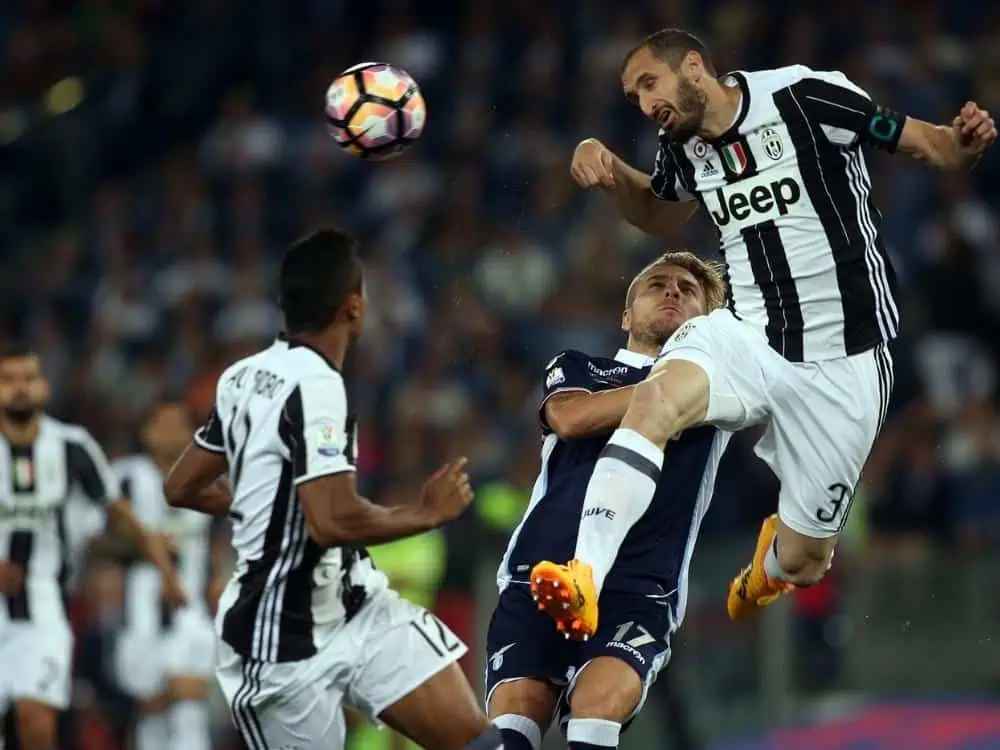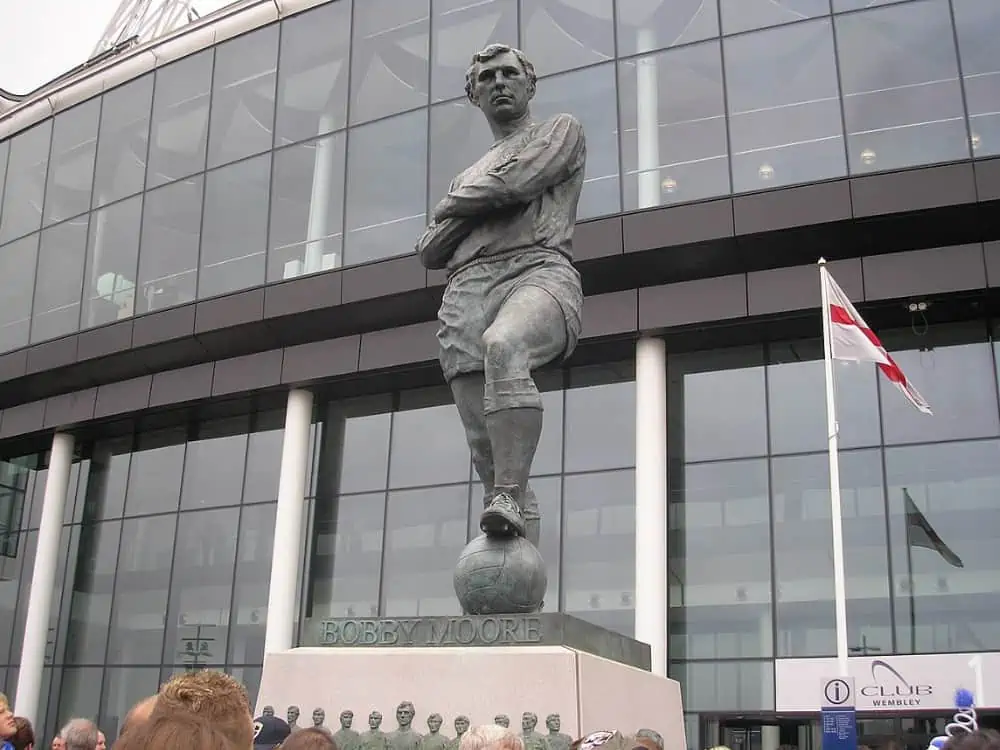Share the post "Sweeper In Soccer (Stopper and Center Back Position)"
The role of a defender has changed a lot in recent decades. Modern defenders are more skillful than ever, balancing offensive and defensive duties more than ever before.
The sweeper soccer defender was a free-roaming center-back that was used frequently by teams from the 1940s to the 1990s. The “libero” was arguably the birth of the modern ball-playing center-back, with a host of different responsibilities to a traditional defender.
This article takes a look at the sweeper position, how it came to be, and its relevance in the modern game. Some of the main areas of focus we’ll touch on include:
- The origin of the position
- Who’s responsible for the sweeper position
- The importance of a sweeper
- How to play as a sweeper
- The best sweepers in soccer
Could old-school sweepers be effective in the modern game? Read on to find out more about this unique position.

What Is a Sweeper In Soccer?
In soccer, a sweeper is a central defender who plays predominantly behind the backline, “sweeping up” loose balls and covering teammates if an opposition player breaks through the defensive line.
We don’t see many sweepers in the modern game. However, they were used effectively for many decades from the 1940s through to the 1980s and beyond.
While the sweeper has a distinct job to pick up any loose balls that seep through the defensive line, the position is relatively fluid. Rather than man-marking an opponent or playing a high-line defensive trap, the sweeper sits behind his or her teammates, reading the game and anticipating the opposing team’s attacking strategies.
The position requires a highly intelligent player with good movement. A sweeper usually plays as the tip in a defensive diamond, behind one or two other center-backs.
This defender moves laterally, watching the game unfold, instructing other defenders, and acting as the last line of defense. Historically, the sweeper was the defensive leader, as he or she essentially had the best view of the game.
Sweepers are usually skilled in possession of the ball. They should be comfortable receiving passes from the goalkeeper and other defenders.
Ideally, a sweeper should be able to dribble through the lines and play penetrating passes from the backline. It is also beneficial if the sweeper is fast, cleaning up any loose balls or over-the-top passes.
Soccer Sweeper FAQs

What Is The Role Of a Sweeper?
The primary role of a sweeper is to break up opposition attacks by intercepting through balls, cutting out long passes, blocking attacker runs, and supporting other defenders.
In many cases, the sweeper simply chases passes, allowing them to run out of play or to reach the goalkeeper safely. The sweeper may also need to clear the defensive line by heading away long passes or kicking loose balls to safety.
Some teams take advantage of the extra player by giving the sweeper on-the-ball responsibilities. In possession, sweepers are known to carry the ball upfield or look for forwarding passes. However, once the sweeper lets go of the ball, he or she must return to a position behind the other defenders.
Sweepers may also play a role in counterattacks. Since the opposition doesn’t necessarily have a designated player to mark the sweeper, he or she can be extremely effective in fast breaks.
The sweeper is typically responsible for taking the ball upfield at speed or arriving late into the penalty box to finish off a chance.
While there are little to no sweepers in the professional game today, many accredit this position with the development of ball-playing center-backs or deep-lying defensive midfielders. These players often leave their set positions to win possession, intercept a pass, or join an attack.
Who Invented The Sweeper Position?
The inventor of the sweeper position is believed to be Karl Rappan, during his reign as a coach for Servette (Switzerland) during the 1930s. Rappan’s defensive position was known as the “catenaccio”, which means “chain”.
The sweeper plays the role of the bolt of the chain, moving in unison behind the rest of the defensive line.
Rappan went on to experience success using this system as Switzerland’s National team coach through the 1930s and 1940s. Essentially, the team transitioned from a modern-day back four to a three-player center-back line.
However, the extra defender would drop behind the other three players, sweeping back and forth throughout the game.
Other coaches and teams took inspiration from Rappan, leading to a significant uptake of the tactic for the next three to four decades. Perhaps the best example of the sweeper position in its heyday was Franz Beckenbauer.
Is The Sweeper Position Important In Soccer?
The sweeper position is no longer very important in soccer. The only constant in today’s game is evolution. Essentially, the sweeper position has developed into two different roles: a ball-playing center back and a defensive midfielder.
Compared to old-style teams, modern formations are much more balanced, with a huge emphasis on defensive shape and structure.
Rather than inviting pressure and defending deep, most teams today defend from the front through a high press. Rather than unbalancing the backline with a sweeper, teams tend to shield their defenders with a midfielder.
Center-backs today are highly skilled in and out of possession. Many have the necessary pace to match opposition strikers. They don’t need an extra player to cover behind or take possession from them.
What’s more, there are now many “sweeper keepers”, who are skilled and confident on the ball and aren’t afraid to leave their penalty box if necessary.
We’ll talk more about a sweeper-keeper later.
How Do You Become a Soccer Sweeper?
While it’s unlikely to start out playing soccer as a sweeper, it is a far more popular position at an amateur level. Effective sweepers should have at least four of five key characteristics:
- Game Intelligence
Arguably the most important trait of a sweeper is soccer IQ. Good positioning ensures defensive breaches and opposition attacks are easier to stop.
- Reading Of The Game
Sweepers must be able to read the game and anticipate risks. This helps ensure they are consistently in the right place at the right time. Effective defenders often look like they aren’t doing much during a game.
However, this is predominantly due to their ability to sniff out danger and read the game well.
- Tackling
When it comes down to brass tax, all defenders must have core ball-winning skills. Whether competing for possession on the ground or in the air, sweepers must possess ball-winning and tackling competency.
While positioning and awareness are essential, if the defender mistimes his or her tackle, they are ineffective.
- Discipline and Patience
Considering the psychological element of the position, the best sweepers tend to demonstrate discipline and patience on the field. The sweeper is often the conductor of the defense so he or she can’t afford to make rash decisions or sprint out of position erratically.
- Athleticism
Athleticism is important in virtually every professional sport. However, central defenders aren’t necessarily known for being the best athletes on the field. This is where sweepers often set themselves apart from the rest.
The best sweepers are quick across the turf and strong. Many possess excellent leaping abilities to compete for aerial balls.

Sweeper Soccer Players
Sweepers soccer players are largely obsolete in today’s game. However, there are some good examples of “liberos” from the past; some of whom you may have heard of. Sir Bobby Moore, the famed English World Cup-winning defender was years ahead of his time in terms of ball-playing ability and technical skill.
Franco Baresi, AC Milan’s player of the century, is another great example of a world-class sweeper. One of the few loyal servants of the game, Baresi, spent his entire 20-year career with Milan. As a person, Baresi developed a reputation as being shy but loyal and hard working. Speaking about loyalty in soccer, he had this to say:
“Today things are different. A player rarely stays with the same team for 15 or 20 years now. The market changed all that – there are a lot more opportunities these days, and they’re tough to resist.”
Franco Baresi
As a player, he was known for his professionalism and dedication to his craft. For both Milan and Italy, he played alongside some of the finest defenders in soccer history: Paolo Maldini, Alessandro Costacurta, and Filippo Galli. His first touch, passing range, and vision made him a deep-lying playmaker.
This technical proficiency combined with mental fortitude and tenacity, led to him becoming a complete defender. Baresi did his best work as a sweeper, where he could display all of his elite attributes.
Best Sweeper In Soccer
Starting out as a midfielder, Franz Beckenbauer eventually become a central defender, revolutionizing the position of the sweeper role. The main difference between Beckenbauer’s interpretation of the position and the previous approach was his role in the offense.
As well as putting in last-ditch tackles and cleaning up behind the defense, Beckenbauer would frequently orchestrate attacks by dribbling out of defense, passing through the lines, and generally dictating the play.
As a player, he endured tremendous success, leading Bayern Munich to multiple league titles, domestic cups, and European championships. He also won the 1974 World Cup and 1972 European Championship with West Germany. Beckenbauer used a sweeper in his coaching days, leading West Germany to another World Cup triumph in 1990.
While the topic is still up for debate, the popular sports and analytics site, Sportskeeda assembled their list of the greatest defenders of all time. Unsurprisingly, all three of the above players made the cut. Here’s a look at the top 10:
| Rank | Player | Team (Primary) |
| 1 | Paolo Maldini | AC Milan |
| 2 | Franz Beckenbauer | Bayern Munich |
| 3 | Franco Baresi | AC Milan |
| 4 | Bobby Moore | West Ham |
| 5 | Gaetano Scirea | Juventus |
| 6 | Roberto Carlos | Real Madrid |
| 7 | Cafu | AC Milan |
| 8 | Alessandro Nesta | AC Milan |
| 9 | Ronald Koeman | Barcelona |
| 10 | Matthias Sammer | Borussia Dortmund |
The Sweeper-Keeper
Today, many goalkeepers play the role of sweeper-keeper. While they don’t have the same duties as a traditional sweeper, they step out from the goal line, commanding their backlines, and looking for signs of danger.
Confident sweeper-keepers also offer themselves as possession outlets, taking the ball from defenders who are under pressure.
Some of the best sweeper-keepers in the world are Ederson (Manchester City) and Alisson (Liverpool). They are essentially playmaking goalkeepers.
Manuel Neuer is another excellent example of a sweeper-keeper. However, he is much more defensive-oriented than Ederson or Alisson.
Soccer Stopper Position
A stopper is a casual term used to describe a regular center-back. Stoppers typically play in pairs or trios, acting as the spine or core of the backline.
While many modern stoppers are effective in possession, their primary role is to defend their goal. Core skills of a stopper include tackling, heading, and blocking.
Soccer Sweeper Vs Stopper
Virtually all modern teams opt for a stopper over a sweeper. Most high-level stoppers are solid all-around players, commanding their backline in and out of possession. Strategy and the overall evolution of the sport have rendered sweepers unnecessary for the majority of teams.
Another reason for the popularity of stoppers over sweepers is the offside rule. Changes to the rule over time, and the introduction of VAR have made it more favorable for backlines to work in unison, creating offside traps.
While it seems unlikely, we may see a revival of the sweeper. In sports, strategy is often cyclical, with managers adopting variations of old tactics to great effect several years after their inception.
What Is The Difference Between a Sweeper And a Stopper?
The primary difference between a sweeper and a stopper is positioning. Stoppers must be disciplined in where they position themselves, stepping in line with their teammates as the ball moves around the field.
Sweepers are essentially free players, using their freedom to spot signs of danger and snuff out opposition attacks. Sweepers may also have a more prominent role in possession, playing forward passes and making occasional runs forward.
Apart from these factors, their main roles remain the same: to prevent the opposition from scoring. While these differences may seem subtle, they are significant when applied to in-game situations.
Share the post "Sweeper In Soccer (Stopper and Center Back Position)"
Joel is a seasoned soccer journalist and analyst with many years of experience in the field. Joel specializes in game analysis, player profiles, transfer news, and has a keen eye for the tactical nuances of the game. He played at various levels in the game and coached teams - he is happy to share his insight with you.



